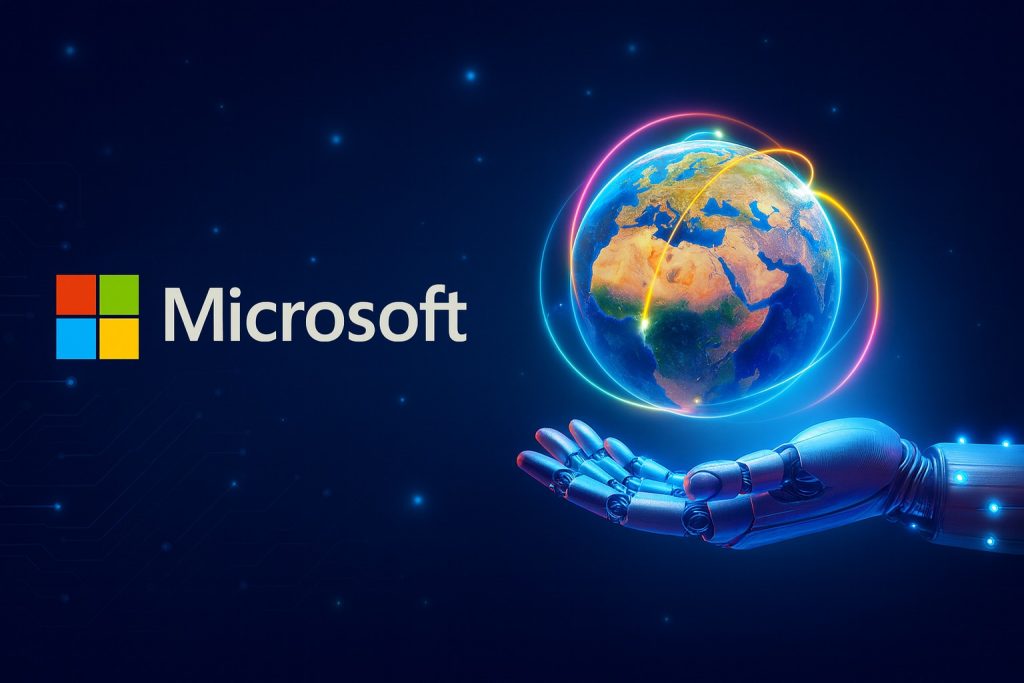Microsoft has unveiled MAI-Image-1, marking the company’s first independently developed text-to-image artificial intelligence model. This launch represents a substantial shift in Microsoft’s AI strategy, signaling deliberate movement toward reduced dependence on its long-standing OpenAI partnership. The model has already secured ninth place on LMArena’s competitive rankings among text-to-image solutions, demonstrating Microsoft’s growing capabilities in autonomous AI development.
This announcement follows two earlier proprietary AI models from Microsoft—MAI-Voice-1 and MAI-1-preview, both released in August. MAI-Image-1 specializes in generating photorealistic imagery featuring natural lighting effects and detailed landscape rendering, while processing user requests faster than many larger, more resource-intensive systems currently available.

Performance Metrics and Competitive Positioning
MAI-Image-1’s top-10 ranking on LMArena reflects its competitive standing within a crowded field of image generation models. The platform, which relies on user voting through pairwise comparison methodology, currently positions the model at ninth place after accumulating more than 4,000 user votes. Microsoft has emphasized that the model was developed with direct input from creative professionals, specifically aiming to avoid the “repetitive or monotonously stylized results” that plague many AI-powered image generators.
The speed advantage inherent in MAI-Image-1 enables practical application across interactive consumer-level tasks, facilitating rapid iteration cycles and seamless integration into creative workflows. While Microsoft hasn’t disclosed architectural details or parameter counts, the company stresses the model’s concentration on photorealistic synthesis with superior lighting accuracy.
What Makes MAI-Image-1 Distinct
Our analysis of available outputs and user feedback on LMArena reveals several characteristics that distinguish MAI-Image-1 from competing solutions:
Lighting and atmospheric rendering: The model demonstrates particular strength in natural light simulation, producing images where light sources, shadows, and reflections behave consistently with real-world physics. This proves especially valuable for architectural visualization and product photography applications.
Processing efficiency: Users report notably faster generation times compared to models with higher parameter counts. This responsiveness matters significantly for iterative creative work where artists test multiple variations rapidly.
Stylistic neutrality: Unlike some AI image generators that impose recognizable aesthetic signatures on outputs, MAI-Image-1 appears more neutral in its default rendering approach, giving users greater control over final visual style through prompt engineering.
Landscape and environment detail: Early testing suggests strong performance in outdoor scenes, natural environments, and complex backgrounds where maintaining coherent detail across large areas challenges many image generation systems.
Strategic Independence from OpenAI Partnership
The launch underscores Microsoft’s broader strategy of building independent artificial intelligence capabilities while maintaining its OpenAI collaboration. The companies recently signed a revised memorandum of understanding in September, granting OpenAI increased flexibility regarding infrastructure partnerships while securing Microsoft’s access to OpenAI technologies through 2030.
Mustafa Suleiman, head of Microsoft’s AI division, previously noted that the company possesses a “huge five-year roadmap” for model development, indicating additional releases ahead. This strategic pivot occurs alongside Microsoft’s integration of Anthropic models into select Microsoft 365 features, diversifying AI implementation beyond the traditional OpenAI partnership framework.
Understanding Microsoft’s Multi-Model Approach
Microsoft’s AI strategy now encompasses three distinct tracks:
Proprietary models (MAI series): Developed entirely in-house, these models—including MAI-Voice-1, MAI-1-preview, and now MAI-Image-1—give Microsoft direct control over model development, training data, and deployment without external dependencies.
OpenAI integration: The company maintains deep integration with GPT models and DALL-E technology through its substantial OpenAI investment and partnership agreement extending to 2030.
Third-party partnerships: Recent Anthropic model integration into Microsoft 365 demonstrates willingness to incorporate additional AI providers, reducing single-vendor reliance.
This diversified approach provides Microsoft with strategic flexibility, competitive leverage, and risk mitigation against potential partnership disruptions or technological limitations in any single AI provider.
Integration Plans Across Microsoft’s Ecosystem
MAI-Image-1 will soon serve as the foundation for image creation features within Microsoft Copilot and Bing Image Creator, complementing the company’s expanding ecosystem of proprietary AI models. The model currently remains available for testing on LMArena, where Microsoft continues gathering user feedback prior to broader deployment.
Anticipated Implementation Timeline
Based on Microsoft’s historical deployment patterns and current testing phase:
Current phase (October 2025): Public testing on LMArena for feedback collection and performance validation across diverse use cases and user populations.
Near-term integration (estimated Q4 2025 – Q1 2026): Progressive rollout into Bing Image Creator, likely beginning with preview or insider programs before general availability.
Medium-term expansion (estimated Q1-Q2 2026): Integration into Microsoft Copilot across various Microsoft 365 applications, potentially including Word, PowerPoint, and Teams for document illustration and presentation enhancement.
Long-term evolution: Continued model refinement based on production usage data, potential mobile application integration, and specialized variants for specific industries or use cases.
Evaluating MAI-Image-1 Against Current Market Leaders
To provide context for Microsoft’s entry into proprietary image generation, we’ve assessed how MAI-Image-1 positions against established competitors based on available information and early user feedback:
Versus OpenAI’s DALL-E 3: DALL-E 3 currently leads in creative interpretation and handling complex, nuanced prompts. MAI-Image-1 appears to prioritize photorealism and natural lighting over artistic interpretation. For strictly photographic outputs, early indications suggest competitive quality, though DALL-E 3 maintains advantages in artistic and stylized generation.
Versus Midjourney: Midjourney’s community and iterative refinement tools create a different user experience focused on artistic exploration. MAI-Image-1’s speed advantages could appeal to users prioritizing rapid iteration over extensive artistic refinement. Midjourney maintains stronger brand recognition and established creative community.
Versus Adobe Firefly: Adobe’s focus on commercial-safe training data and native integration into Creative Cloud applications positions Firefly differently than MAI-Image-1. Microsoft’s eventual Copilot integration could create similar ecosystem advantages within the Microsoft 365 environment.
Versus Stable Diffusion: Open-source Stable Diffusion offers customization and local deployment that closed commercial models cannot match. MAI-Image-1 targets users prioritizing ease of use, enterprise support, and cloud integration over maximum customization flexibility.
Technical Considerations and Limitations
Microsoft’s decision not to disclose architectural details or parameter counts prevents deep technical assessment, but several factors warrant consideration:
Training data transparency: Like most commercial AI image generators, Microsoft hasn’t fully disclosed training data sources, raising ongoing questions about copyright, compensation for artists, and potential biases in output.
Prompt engineering learning curve: Early users report that optimal results require understanding MAI-Image-1’s particular prompt interpretation patterns, which differ somewhat from competing models. This creates initial friction but becomes less significant with experience.
Limited style versatility: The focus on photorealism, while producing strong results in that domain, may limit creative applications requiring distinct artistic styles. Users seeking heavily stylized outputs might find competing models more suitable.
Integration dependency: Maximum value extraction likely requires deep investment in Microsoft’s broader ecosystem, particularly for planned Copilot and Bing Image Creator integration. Standalone usage through LMArena provides access but misses integrated workflow benefits.
What This Means for Microsoft’s AI Trajectory
MAI-Image-1 represents a pivotal moment in Microsoft’s evolution from AI infrastructure provider to direct competitor in the generative AI market. The company’s substantial cloud computing infrastructure through Azure, combined with growing proprietary model capabilities, positions Microsoft to compete across the full AI stack rather than primarily enabling other companies’ AI products.
The timing proves particularly significant as AI partnerships face scrutiny from regulators concerned about market concentration and competitive dynamics. Developing independent capabilities provides Microsoft with strategic options regardless of how partnership landscapes evolve.
For enterprise customers already invested in Microsoft 365 and Azure, MAI-Image-1’s integration into familiar tools could accelerate adoption compared to standalone AI image generation platforms requiring separate subscriptions and learning curves.
Early User Feedback and Reception
Based on LMArena voting patterns and early tester commentary, several themes emerge regarding MAI-Image-1’s reception:
Positive responses:
- Appreciated speed and responsiveness for iterative work
- Strong performance on architectural and product photography prompts
- Natural lighting and shadow rendering praised by photography-focused users
- Integration anticipation from Microsoft ecosystem users
Areas for improvement:
- Requests for greater artistic style range beyond photorealism
- Some users report inconsistency in human figure rendering, particularly hands and complex poses
- Desire for more transparent documentation about capabilities and limitations
- Questions about training data sources and artist compensation
Testing MAI-Image-1 Yourself
The model currently remains accessible for testing through LMArena, providing opportunity to evaluate performance against your specific use cases before Microsoft’s broader integration deployment. Testing now allows you to:
Develop prompt engineering familiarity: Understanding how MAI-Image-1 interprets different prompt structures, lighting descriptions, and composition cues before production integration.
Assess fit for your workflows: Determining whether the model’s photorealistic focus and speed advantages align with your creative or business requirements.
Contribute to development: Your voting and feedback on LMArena directly influences Microsoft’s refinement priorities and helps shape the model’s evolution.
Compare across alternatives: LMArena’s pairwise comparison methodology lets you directly evaluate MAI-Image-1 against competing models for your specific needs.

Strategic Implications for the AI Market
Microsoft’s move into proprietary text-to-image generation signals broader market maturation trends:
Vertical integration: Major technology companies increasingly prefer developing internal AI capabilities rather than remaining solely dependent on partnerships or external providers.
Differentiation through integration: Competitive advantage increasingly derives from how AI models integrate into broader product ecosystems rather than standalone model performance alone.
Speed and efficiency focus: Microsoft’s emphasis on processing speed suggests market recognition that practical usability often matters more than marginal quality improvements that dramatically increase resource requirements.
Multi-model strategies: Leading organizations pursue diversified AI approaches incorporating proprietary models, strategic partnerships, and selective third-party integrations rather than committing exclusively to single providers.
Looking Ahead: Microsoft’s AI Model Roadmap
Mustafa Suleiman’s reference to a “huge five-year roadmap” indicates that MAI-Image-1 represents just one component of Microsoft’s broader proprietary AI development plans. Based on current trajectory and industry patterns, potential future developments might include:
Specialized industry variants: Medical imaging, architectural visualization, product design, and other domain-specific versions optimized for particular professional applications.
Video generation capabilities: Natural progression from static image generation to video synthesis, potentially building on MAI-Image-1’s photorealism strengths.
Enhanced multimodal integration: Combining MAI-Image-1’s visual generation with MAI-Voice-1’s audio capabilities and language model integration for comprehensive content creation.
Edge deployment options: Optimized versions for local execution on devices with appropriate hardware, reducing cloud dependency for privacy-sensitive applications.
Fine-tuning and customization tools: Enterprise features allowing organizations to adapt the base model for specific brand guidelines, product catalogs, or proprietary visual styles.
Positioning Within Microsoft’s Broader AI Vision
MAI-Image-1 fits within Microsoft’s comprehensive AI strategy extending across consumer products, enterprise solutions, and infrastructure services. The model’s planned integration into Copilot positions it as a content creation tool within Microsoft’s vision of AI-augmented productivity across personal and professional contexts.
This contrasts somewhat with competitors pursuing AI image generation primarily as standalone creative tools or embedded features within design software. Microsoft’s approach emphasizes accessibility within existing workflows rather than specialized creative applications, potentially accelerating mainstream adoption while possibly limiting appeal among professional artists seeking dedicated creative tools.
The success of this strategy depends largely on execution quality within Copilot and related products. Strong integration that feels natural and genuinely enhances productivity could drive significant usage, while clumsy implementation or intrusive AI suggestions might limit adoption regardless of underlying model capabilities.
Microsoft’s entry into proprietary text-to-image AI generation with MAI-Image-1 marks a meaningful inflection point in both the company’s AI trajectory and the broader generative AI market structure. The model’s competitive LMArena ranking demonstrates technical credibility, while planned ecosystem integration suggests potential for substantial real-world impact.
For users, the practical implications depend heavily on existing platform investments and specific use cases. Those already embedded in Microsoft’s productivity ecosystem will likely find MAI-Image-1 integration valuable for document illustration, presentation enhancement, and rapid concept visualization. Users prioritizing artistic expression or requiring specialized creative tools may continue finding dedicated platforms more suitable.
As Microsoft continues gathering feedback through LMArena testing and refining the model ahead of broader deployment, the coming months will reveal whether MAI-Image-1 represents a genuine competitive alternative to established image generation leaders or primarily serves as a strategic hedge within Microsoft’s diversified AI approach.




Post a comment